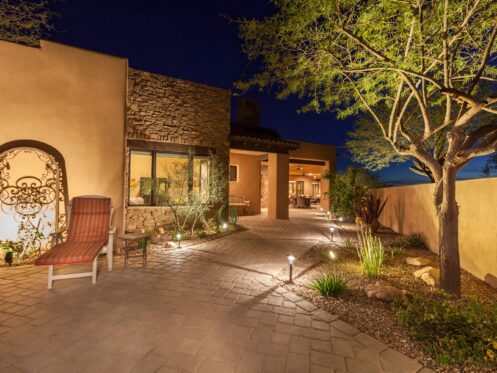Lighting can be a sneaky consumer of electricity in your house. In many households, lighting is responsible for 10 to 15 percent of energy consumption. Consequently, lighting upgrades should be an early target in achieving greater energy efficiency. Here is a closer look at some lighting upgrades that will yield the best efficiency improvements.
Conversion to LED Lights
LED lights have already replaced a lot of more traditional solutions in most homes. However, many households still have a few incandescent or halogen lights chewing into their electric bills. You especially see this with specialized lighting solutions, such as spotlights and floodlights. Many people still also use older styles of lights to cover large interior areas.
Locating and replacing traditional lights with LED systems is an easy way to improve energy efficiency. Foremost, LEDs often consume as little as one-seventh the power as their older counterparts. Likewise, LEDs frequently last for 25 times more hours, saving you money on replacements. Intriguingly, LED lights tend to run cooler, too. Moving to an LED-only system can keep your place cooler, cutting electric bills by reducing air conditioning usage.
If you’re not prepared to hunt down and replace every older light in your home, at least strategically replace the worst offenders. Moving to LEDs in high-use locations like the bathroom and kitchen can reduce costs. Likewise, you can target high-output lights like outdoor directional lights.
Sensors
Supporting technologies can be just as important for lighting efficiency as the bulbs themselves. Modern sensors make it easy to detect movement and occupancy in a variety of rooms. This is especially beneficial in spaces where people often get busy or distracted and forget to turn off lights, such as workshops, basements, laundry rooms, patios, and garages.
Modern sensors offer a variety of options. Photosensors can detect the ambient light present in a space, providing automatic control for dust-to-dawn operations. For example, many people use photosensors for outdoor security lights and walkway lights. The best models mix photosensors with other solutions so the lights only kick on at appropriate times and when someone is present.
Passive infrared (PIR) sensors are one of the simpler solutions on the market. A PIR sensor detects heat from people who are moving around in a room. People often refer to standard PIR sensors as motion sensors. Whenever someone moves into a room, the PIR sensor automatically turns the light on. The PIR can then flip the light off when no one is detected. Once more, mixed sensor packages can make these more efficient by detecting whether the available ambient lighting is already sufficient to avoid turning on the light.
Ultrasonic sensors offer better detection around walls. These are popular solutions for oddly shaped spaces. They perform well at detecting when people are behind walls or partitions. Also, they do well at detecting people around corners. For example, a bathroom with several coves might benefit from ultrasonic sensors.
A less common sensor technology uses microwave frequencies. The emitted light waves bounce off people at different rates when they’re moving. Even slight movements that occur unconsciously while people sit are enough to keep the sensor active. If you want a more active sensor solution that can cover a large space, you may want to look into microwave technology.
Smart Technologies
Smart technologies are another solution that can make lighting dramatically more efficient. Programmable lighting systems allow you to schedule lights. Especially if you want to be sure the lights will be off whenever you’re not home, this approach is advantageous. Likewise, you can schedule the lights to kick on when you normally return.
Geofencing makes smart lighting even better. A geofence is a system that uses GPS, Bluetooth, and Wi-Fi technologies to determine if you’re nearby. For example, you can set the lights in your garage to come on when your car is close to home. The light can then turn off when they detect that you’ve walked from the garage into your house. Not only is this highly convenient, but it ensures that you’ll never accidentally leave the light on behind you.
Usage monitoring in smart systems can help you identify waste, too. If you see a lot of lights are on frequently in a particular part of your home, you can then target them for high-efficiency replacements. Likewise, the data can be useful for determining how to program the lighting in your home.
Electrical Panel Upgrades
Electrical panels are upstream from lighting, but they do significantly affect the efficiency of lights. An upgraded electrical panel can make every circuit with lighting on it more efficient. New circuit breakers are broadly more efficient. Also, available smart circuit breakers can give you a more refined picture of what lighting usage amounts to in total wattage.
Smart panels and circuit breakers allow you to even turn off underutilized circuits. This prevents lights from becoming energy vampires while they maintain low-power states to stay ready to come on. If you have a location like a craft room or guest bedroom that you rarely use, you can have the smart circuit breaker cut power entirely to that space.
Even better, many modern smart systems allow you to quickly activate or deactivate breakers from an app on your phone. When you do need to use a room, simply whip out the app and send power. Once you’re done, you can turn the breaker back off, saving significant energy.
Lighting Temperature Choices
Lighting temperature refers to whether the light in a space is warm or cool. Warm light is low-power light like you might have in your living room while you watch TV. Conversely, a cool light is a brighter one that illuminates a space well, such as you might have at a kitchen counter or a workbench.
Many people make the mistake of adding more lights because they are running warm lighting where they should be using cool lighting. For example, people oftentimes turn on an extra light in the kitchen because they can’t see well. Choosing the right temperature for your location’s lighting can reduce the need for added lights, ultimately reducing energy consumption. As a general rule, warm lighting is best for relaxation while cool lighting is best for spaces where you perform tasks.
Payback
Most lighting upgrades are fairly cost-effective. Consequently, payback periods for upgrades are short compared to most other household improvements. Most sensors take between six months and three years to pay back their costs. LED bulbs often pay for themselves in under a year. Even a complex upgrade like a whole-home smart lighting system has a payback period of about four years.
Ultimate Homes Cooling and Electrical handles all kinds of electrical services projects for folks in Cape Coral, FL and the surrounding areas. We are fully licensed and have excellent online reviews. From putting in new lights to replacing electrical panels, we do high-quality work.
If you’re interested in how lighting upgrades for your Cape Coral home can improve efficiency, contact Ultimate Homes Cooling and Electrical today.


